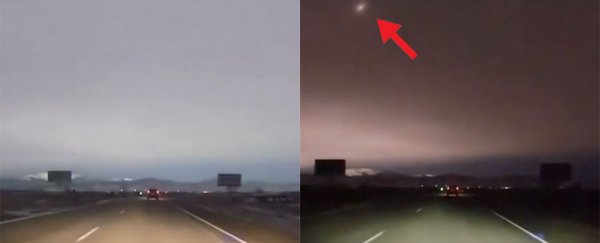A huge fireball hurtled across the night sky in Siberia early on Tuesday evening, momentarily turning night into day for thousands of startled residents below.
The amazing spectacle, which passed over the southern Siberian republic of Khakassia, is suspected to have been a meteor burning up in Earth's atmosphere. While the object is not thought to have made impact on the surface, witness reports suggest it may have exploded during descent.
"I went for a walk with my friends. We stopped by the shop and my friend screamed when she saw a bright flash, and then there was an explosion," a local woman told The Siberian Times.
"All the car alarms immediately went off. We were so scared. My father said windows were vibrating."
Several videos of the event uploaded to social networks show the fireball streaking across the sky, accompanied by a brilliant display of light that temporarily made the night scenery resemble day time.
Check out the backdrop to these families enjoying a skating rink:
"At first, I couldn't understand what's going on. There was a sudden luminescence. It wasn't as light as day, but still quite bright," one witness told Russian news outlet RT.
"We looked at the mountain near us… and there was [a] huge meteor flying above it. It had a tail. Frankly, I was scared. I thought that it was a bomb."
Despite the panic on the ground, Russian authorities downplayed the incident, suggesting the meteor completely burned out in the atmosphere, possibly above the city of Sayanogorsk.
"At 6:50pm in southern districts of Khakassia republic, a shining object was visible in the sky," the Emergencies Ministry said in a statement to media.
"Working groups of the Emergencies Ministry initiated checks on main industrial sites. All of them are working normally."
Residents in the Russian city of Sayanogorsk witnessed a dazzling sight when a meteor streaked through the night sky https://t.co/ZxPP6kdyyV pic.twitter.com/98zHSqTnjT
— ABC News (@ABC) December 7, 2016
In the event that any fragments of the meteor had made it to the ground, authorities speculated that they would have landed in a region called the Babik Valley, with a team being dispatched to search the area.
"[The meteor] was several times smaller than the one over Chelyabinsk, but its fragments may be found," physicist Viktor Grokhovsky from Ural Federal University told RT.
"Determining where they landed would require accurate calculation of its path. This may take a day or so."
The Chelyabinsk meteor entered Earth's atmosphere over Russia in 2013 and exploded in the air, generating a huge shock wave estimated to be almost 30 times as powerful as the atomic bomb detonated at Hiroshima in World War II.
Several thousand buildings were damaged by the shockwave, and roughly 1,500 people were injured, mostly by broken glass and the intense light caused by the meteor.
While Russian scientists are at somewhat of a loss to explain more about the latest meteor – since researchers don't have observatories monitoring that specific area – the reports from witnesses suggest the object this week was significantly less dangerous.
"Judging by the fact that it burned up or exploded before reaching [the] surface, it's obvious that it can hardly be more than 10 or 15 metres in size and that apparently it is not made of iron," Natan Eismont, head scientist of the Space Research Institute (IKI) at the Russian Academy of Sciences, told Russian news agency TASS – adding that such objects rarely pose a risk to humans.
That assessment is backed up by NASA's Paul Chodas, who manages the Jet Propulsion Laboratory's Near-Earth Object office.
"There were no reports of a shockwave. That tells me it was not a large meteor like Chelyabinsk," he told Hayley Miller at The Huffington Post.
"Something like this probably happens every day or two. Just not necessarily over populated areas."
